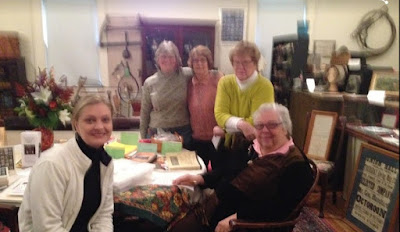So I went. The question is "Which house on Turkey Lane did Isaac and Miriam Pearson live in in 1850?"
Well that seems like an odd question. But I'm in their town and I know the street, so there's a chance the original home is there since 150 year old homes are not uncommon in this area.
Family member name: Isaac and Miriam Pearson
Relationship to me: My dad's dad's mom's dad's parents. My 3x great grandparents.
Well that seems like an odd question. But I'm in their town and I know the street, so there's a chance the original home is there since 150 year old homes are not uncommon in this area.
Family member name: Isaac and Miriam Pearson
Relationship to me: My dad's dad's mom's dad's parents. My 3x great grandparents.
The Cumberland Historical Society in Maine is in a historical (go figure) one-room school house that is jammed to the ceiling with town artifacts. Four grandmas are the trustees of the town's history and they know their stuff. They're pleasantly chatty too. Carolyn said she found some information for me about my Pearson family. What could it be??
Non-Googleable Point #1
An old 1851 map of the town with "J. O. Piersen". I sighed for a moment, thinking it was the wrong family. However, a closer look at the handwritten initials showed it was "I. O." who else has the initials I.O. but my 3x great grandpa, Isaac O. Pearson?
Non-Googleable Point #2
What street is it? I knew they lived on Turkey Lane because I have a handwritten note from one of their granddaughters who was cleaning out their house on Turkey Lane. But the map corresponded with modern day Range Road. The plot thickens!
Non-Googleable Point #3
Wait! Carolyn brought me to consult another map hanging on the wall. It was hand-drawn with extra tidbits and drawings of the old homes of the town. It showed Turkey Lane was parallel to Range Road, and at one time went all the way through, but now is a short dead end street. So the Pearson home was in between Range Road and the old Turkey Lane. Perhaps the front door faced Turkey Lane.
Ok, fine, this is Googleable
The old map also showed "G. Hall" was next door to the Pearsons. I remembered this was true from every US Census of Cumberland. The Pearsons were neighbors to Greenfield Hall, who I knew had to be a relative.
And this is on Google Maps
Range Road is completely straight, except for one curve in the road where the Pearson's and Hall's were on the map. I asked Carolyn if the road is still that way. Yes!
It took me and mom 5 minutes to drive to Range Road (deducting the time we spent detouring down Turkey Lane just to check it out and take a picture.)
So, combining the facts above, the answer to the question: "Which house on Turkey Lane did Isaac and Miriam Pearson live in in 1850?"
Isaac and Miriam Pearson lived at what is now 163 Range Road. The lot is still there, but the original home is not.









